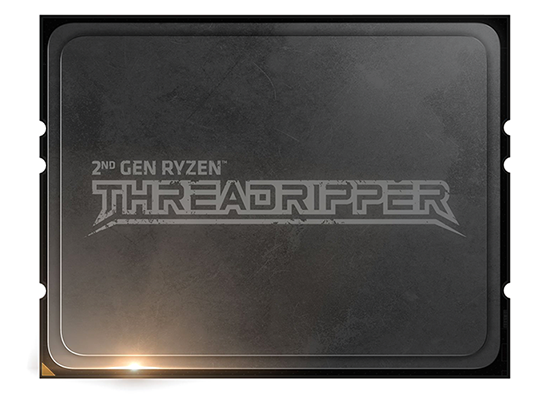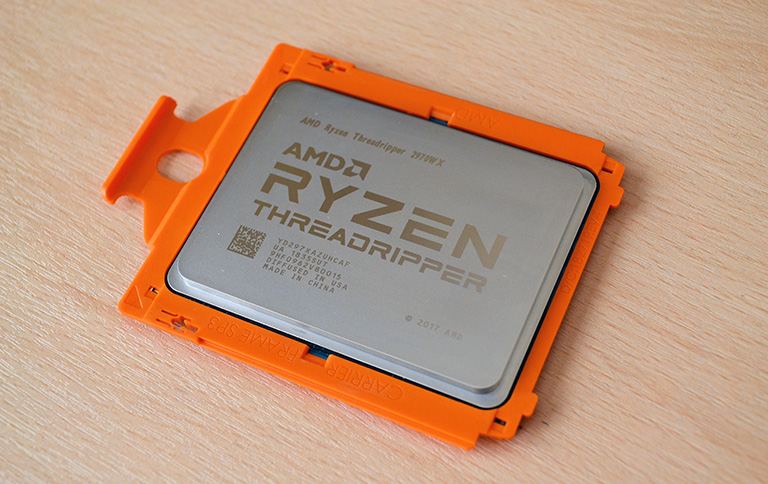Introduction

2nd Generation Ryzen Threadripper came roaring into town in August. Initially comprising the 32C64T monster 2990WX and a more restrained 16C32T model going by the name 2950X, AMD promised later availability for a further two Threadripper 2 chips. That 2970WX and 2920X make their retail appearance today.
Pulling out the usual table offers insight into what they offer to those willing to invest in the AMD TR4 platform.
AMD Ryzen product range |
||||||||||
|---|---|---|---|---|---|---|---|---|---|---|
| Model | Cores / Threads |
TDP |
L3 Cache |
Base Clock |
Turbo Clock |
Process |
PCIe |
DDR4 Support |
Package |
Price |
| AMD Ryzen 2nd Gen Threadripper | ||||||||||
| Ryzen Threadripper 2990WX | 32 / 64 |
250W |
64MB |
3.0GHz |
4.2GHz |
12nm |
64 |
Quad 2933 |
TR4 |
$1,799 |
| Ryzen Threadripper 2970WX | 24 / 48 |
250W |
64MB |
3.0GHz |
4.2GHz |
12nm |
64 |
Quad 2933 |
TR4 |
$1,299 |
| Ryzen Threadripper 2950X | 16 / 32 |
180W |
32MB |
3.5GHz |
4.4GHz |
12nm |
64 |
Quad 2933 |
TR4 |
$899 |
| Ryzen Threadripper 2920X | 12 / 24 |
180W |
32MB |
3.5GHz |
4.3GHz |
12nm |
64 |
Quad 2933 |
TR4 |
$649 |
| AMD Ryzen Threadripper | ||||||||||
| Ryzen Threadripper 1950X | 16 / 32 |
180W |
32MB |
3.4GHz |
4.0GHz |
14nm |
64 |
Quad 2666 |
TR4 |
$999 |
| Ryzen Threadripper 1920X | 12 / 24 |
180W |
32MB |
3.5GHz |
4.0GHz |
14nm |
64 |
Quad 2666 |
TR4 |
$799 |
| Ryzen Threadripper 1900X | 8 / 16 |
180W |
16MB |
3.8GHz |
4.0GHz |
14nm |
64 |
Quad 2666 |
TR4 |
$449 |
| AMD Ryzen 7 | ||||||||||
| Ryzen 7 2700X | 8 / 16 |
105W |
16MB |
3.7GHz |
4.3GHz |
12nm |
24 |
Dual 2933 |
AM4 |
$329 |
| Ryzen 7 2700 | 8 / 16 |
65W |
16MB |
3.2GHz |
4.1GHz |
12nm |
24 |
Dual 2933 |
AM4 |
$299 |
| Ryzen 7 1800X | 8 / 16 |
95W |
16MB |
3.6GHz |
4.0GHz |
14nm |
24 |
Dual 2666 |
AM4 |
$349 |
| Ryzen 7 1700X | 8 / 16 |
95W |
16MB |
3.4GHz |
3.8GHz |
14nm |
24 |
Dual 2666 |
AM4 |
$309 |
| Ryzen 7 1700 | 8 / 16 |
65W |
16MB |
3.0GHz |
3.7GHz |
14nm |
24 |
Dual 2666 |
AM4 |
$299 |
| AMD Ryzen 5 | ||||||||||
| Ryzen 5 2600X | 6 / 12 |
95W |
16MB |
3.6GHz |
4.2GHz |
12nm |
24 |
Dual 2933 |
AM4 |
$229 |
| Ryzen 5 2600 | 6 / 12 |
65W |
16MB |
3.4GHz |
3.9GHz |
12nm |
24 |
Dual 2933 |
AM4 |
$199 |
| Ryzen 5 1600X | 6 / 12 |
95W |
16MB |
3.6GHz |
4.0GHz |
14nm |
24 |
Dual 2666 |
AM4 |
$219 |
| Ryzen 5 1600 | 6 / 12 |
65W |
16MB |
3.2GHz |
3.6GHz |
14nm |
24 |
Dual 2666 |
AM4 |
$189 |
| Ryzen 5 2400G | 4 / 8 |
65W |
4MB |
3.6GHz |
3.9GHz |
14nm |
16 |
Dual 2933 |
AM4 |
$169 |
| Ryzen 5 1500X | 4 / 8 |
65W |
16MB |
3.5GHz |
3.7GHz |
14nm |
24 |
Dual 2666 |
AM4 |
$174 |
| Ryzen 5 1400 | 4 / 8 |
65W |
8MB |
3.2GHz |
3.4GHz |
14nm |
24 |
Dual 2666 |
AM4 |
$169 |
| AMD Ryzen 3 | ||||||||||
| Ryzen 3 2200G | 4 / 4 |
65W |
4MB |
3.5GHz |
3.7GHz |
14nm |
16 |
Dual 2933 |
AM4 |
$99 |
| Ryzen 3 1300X | 4 / 4 |
65W |
8MB |
3.5GHz |
3.7GHz |
14nm |
24 |
Dual 2666 |
AM4 |
$129 |
| Ryzen 3 1200 | 4 / 4 |
65W |
8MB |
3.1GHz |
3.4GHz |
14nm |
24 |
Dual 2666 |
AM4 |
$109 |
Understanding Ryzen Threadripper 2970WX and 2920X
The core-and-thread differences amongst the Threadripper 2 range are totally sensible given how AMD deals with the multiple dies present in these ultra-performance processors. Let's explain.
WX-suffixed processors use four 213mm dies that each contain eight cores while X-series chips use two dies. This means there is a maximum 32C64T and 16C32T available to them, respectively. A knock-on effect of having extra dies is, obviously, transistor budget and additional power requirements.
The heavyweight Ryzen Threadripper 2970WX carries a staggering 19.2bn transistors hewn from the latest 12nm process used on Zen+ processors. Appreciating that 'only' 24C48T are active in this implementation, six out of eight cores are used in each of the four dies, and this is also why it shares that 250W TDP with its bigger, more expensive brother, the 2990WX.
Really, 2970WX is a core-deactivated version of the 2990WX. The pair of workstation-focussed chips share heck of a lot, including base and boost speeds, L3 cache, access to a quad-channel DDR4-2933 memory interface, and PCIe lanes. Knowing L2 cache is linked in with cores means it drops from 16MB to 12MB for the 2970WX.
And that's your lot. The simple reason for the 2970WX's introduction is to enable AMD to play in the $899- $1,799 price point that, until this chip's availability, was market potential gone begging. More pertinently for anyone looking to invest in this extreme HEDT field, 2970WX's $1,299 asking fee makes it a natural competitor to the Intel Core i9-7920X (12C24T) and Core i9-7940X (14C28T)
The now-familiar TR4 package
Bringing more affordability to the 2nd Generation Ryzen Threadripper range is the remit of the 2920X CPU. Its base specifications are very similar to last year's 1920X, but now armed with a lower street price of $649 and imbued with the goodness that is present in all second-gen chips, it is able to boost to a higher speed of 4.3GHz and uses faster DDR4-2933 memory.
Presented in exactly the same form factor as all other TR4 chips, it makes a lot of sense for those looking to step into TR4 waters but not make a splash by investing too much on the CPU alone. Ostensibly a workstation chip pressganged into the HEDT segment, the 24 threads ought to make light work of multi-threaded tests.
Appreciating the pricing is reasonably close to the Intel Core i9-9900K, representing the best that either company's mainstream processors have to offer, the performance comparison between the 12C24T and 8C16T duo will be interesting - Intel wins out on frequency; AMD on threads.
Dynamic Local Memory
All good for the WX as a powerhouse CPU, right? Well, not quite, because many-many-core processors such as the 2990WX and, one would assume, the 2970WX fall foul of Windows not being able to efficiently handle them with respect to gaming. For example, the results from the out-of-the-box 2990WX were poor at lower resolutions, ostensibly because games couldn't manage all those threads well.
Nothing changes on that front with the 2970WX, but you may also remember that these processors' four-die architecture brings some other wrinkles into play. Only two of the four dies are attached directly to memory controllers, with the other two having to access system RAM by jumping over to the direct-attached die via Infinity Fabric. Fast though it is, this jump adds latency penalties which reduce absolute performance. 2950X and 2920X don't have this problem as their two dies are attached directly to DDR4.
The previous workaround for this latency problem was to switch between local or distributed memory modes, availed by a toggle within AMD's Master Ryzen utility that required a reboot to take effect. Cumbersome is a conservative word to describe the process.
Introduced for the WX-series processors with this launch, AMD is debuting what it calls the Dynamic Local Memory (DLM) mode. On by default within Windows 10, DLM, according to AMD, 'measures how much CPU time each thread on the system is consuming. These threads are then ranked from most to least demanding, and the top threads are automatically pushed to the CPU cores that contain direct memory access. Once these cores are consumed by work, additional threads are scheduled and executed on the next available CPU core. This process is continuous while the service is running, ensuring the most demanding threads always get preferential time on cores with local memory.'
The premise is to enable light-load applications with few threads to run on direct-attached DRAM. Sure, if you go over 24 threads on the 2970WX then some will have to be run over the Infinity Fabric, yet most latency-sensitive applications tend not to be that threaded.
Thinking about it for a moment, the biggest gains will be seen in games, because ensuring their engines have fast(er) access to local memory ought to boost what has been anaemic performance. DLM works on the fly and is invisible to the user, and we're keen to see how it plays out in the benchmarking section. Let's head over to that.










